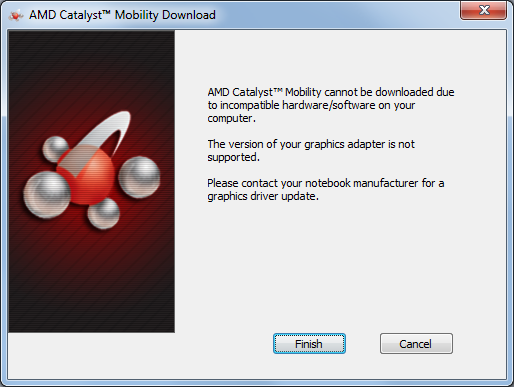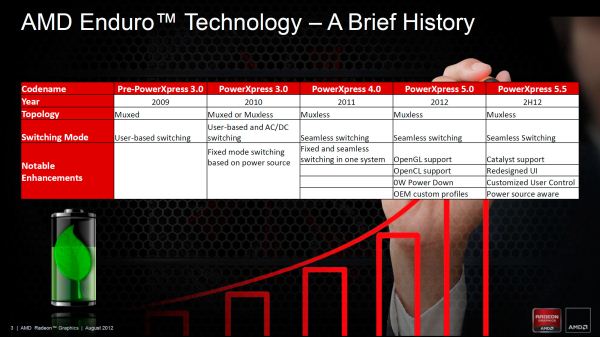AMD’s Enduro Switchable Graphics Levels Up
by Jarred Walton on September 6, 2012 3:00 AM ESTRecap: AMD’s PowerXpress, aka Dynamic Switchable Graphics, aka Enduro
Getting back to the switchable graphics, AMD has gone through a variety of names over the years. Here’s AMD’s summary slide, which I’ll discuss in detail:
Originally introduced as PowerXpress back in 2008, the first AMD switchable graphics solutions were like that found later in the ASUS UL80Vt and similar laptops: you had to flip a switch, and in the first iterations you would then need to reboot the laptop so that the BIOS could disable the discrete GPU and activate the integrated GPU. It was messy and a bit inconvenient, and NVIDIA’s early studies showed that many users ended up not using the feature—they would either run on dGPU all the time or on iGPU all the time. Both AMD and NVIDIA had a second series of switchable graphics designs where the need to reboot was removed; the first Alienware M11x could switch GPUs in about 10-15 seconds, and the same was true of HP’s first ENVY laptops. These were using PowerXpress 2.0 and 3.0, and for most people the switching side was adequate: you’d run on dGPU when plugged in and switch to iGPU when on battery power.
Last year, AMD took a step forward with their switchable graphics by introducing PowerXpress 4.0, which also renamed the technology to Dynamic Switchable Graphics (DSG for short). I got a chance to do a head-to-head of the technology using a Sony VAIO C laptop provided by NVIDIA. You know a company is confident that they’re going to win a technology comparison when they’ll actually give you a competitor’s product. In some cases, DSG was just as good as Optimus: you could launch a supported game and never realize all the extra stuff happening in the background; unfortunately, there were several titles where it wasn’t quite as convenient as we would have liked, and OpenGL support from DSG was completely missing.
Step forward to early 2012 and we got another update to PowerXpress 5.0 (note that PowerXpress is now only used internally by AMD and hasn’t been their marketing name since before PX4.0) along with a rechristening: Dynamic Switchable Graphics was out and Enduro was in. If nothing else, at least it makes my job easier as Enduro is much more concise. There's also the fact that the GPUs are no longer "switching", as the iGPU is always running; now the dGPU is simply supplementing the iGPU when needed. Along with the name change, AMD added OpenGL and OpenCL support to the mix, and with their Zero Core Technology (which is also part of their 7000 series desktop GPUs—a case of mobile design influencing desktops) the need to keep a small portion of the chip alive (aka BACO: Bus Active Chip Off) was removed. OEMs could also ship with custom profiles for applications, so for example Dell might want all of their extra utilities to default to running on the iGPU.

Hopefully this problem goes away next month!
Other than those changes, the UI and driver updates situation on early Enduro solutions remains largely the same as with DSG/PX4.0—and that’s what I initially received with the Clevo P170EM, with drivers from around March 2012. A quick check at AMD’s site also let me know that there weren’t any new drivers available, as the P170EM wasn’t currently supported by the latest Mobility Catalyst drivers.











200 Comments
View All Comments
JarredWalton - Thursday, September 6, 2012 - link
I have a P170EM with the beta drivers, and AMD says they're basically undergoing final QA before release this month or next. I brought up this issue over a year ago, so obviously AMD is moving slowly, but it looks like they're about ready to address things. Finally. I wouldn't go out and buy a 7970M solution today with the intention to wait for the public driver updates to start coming, but rest assured we will be testing with the public drivers when they launch, and when they update again we'll test again.I should also note again (as I did in the article) that the GCN architecture cards have not had the best performance consistency since launch until the latest drivers -- and that's on the desktop. Everyone running GCN on laptops is basically looking at drivers that are 3+ months old (unless they have a laptop that doesn't use Enduro, in which case they ought to have been able to update to the 12.7 Catalyst release).
arcticjoe - Thursday, September 6, 2012 - link
Jarred download MSI Kombustor (its a very small download and has a GPU utilization graph so you can see the Enduro issue very quickly) and run it with default settings (DX10 and DX11 modes work ok and give you 99% utilization and good fps). If your utilization is bellow 99% then these new drivers fixed nothing.JarredWalton - Thursday, September 6, 2012 - link
Note that there are no "DX10 or DX11" modes -- everything is OpenGL as far as I can see. So even though the EXE name is msikombustordx11.exe, the rendering is done via OpenGL. That could be a problem, as up until Enduro OpenGL wasn't even supported by AMD's dynamic switchable graphics, but it appears to be working (mostly?) now.Utilization for the Furry and Stessy Test (GL4) starts low for the first ~10 seconds (and there were a couple rendering glitches) and then jumps to 98% with no more flashes or rendering errors. FPS at 1080p 2xAA is 13. Other tests show a similar low GPU utilization for the first few seconds and then jump to 90% or higher. I'm not sure what's going on, but I don't think the GPU utilization is accurate right at the start.
Anyway, saying "anything below 99% in Kombustor isn't right" seems rather extreme, particularly since Kombustor is based off of Furmark. What about GPU utilization in games? Let me run a few tests, but if you know of any specific games where there are problems, I can try to test those.
arcticjoe - Thursday, September 6, 2012 - link
Thanks for testing Jarred. I think (i'm at work at the moment, cant check) there is a tab for a "burn in test" which allows your to switch rendering between openGL and DX9/10/11.JarredWalton - Thursday, September 6, 2012 - link
Okay, that helps -- I wasn't sure exactly which test you wanted. Here are the full results at 1080p:OGL2: 92% utilization
OGL3: 91% utilization
DX9: 90% utilization
DX10: 99% utilization
DX11: 99% utilization
There's still a ~5 second gap between starting and full load showing up, but that appears to be a "works as intended" sort of thing. Batman: Arkham City incidentally is showing 99.7% GPU load at 1080p Extreme settings.
If you have specific games you'd like me to check, let me know. I'm going to see about digging into this a bit more today.
Seanzky - Thursday, September 6, 2012 - link
Thank you!arcticjoe - Thursday, September 6, 2012 - link
Batman is one of the games I get unstable utilization (60-90%), so 99% sounds very promising.JarredWalton - Thursday, September 6, 2012 - link
So just a quick update:At extreme settings, GPU utilization is 99.7%. At Medium settings, however, GPU utilization is much lower: around 47%.
I ran a similar test with DiRT 3. At Ultra High, I got GPU use of around 90% on average. Drop that to Medium and utilization drops to more like 50%.
I guess the question is whether the GPU utilization is low because AMD is specifically trying not to use more GPU than needed (e.g. once you break 60 FPS, there's no much point in rendering faster on a 60Hz LCD panel), or if there's some other reason for the low GPU use. I'd also guess that it can be fixed with drivers; how high a priority that is remains to be seen.
arcticjoe - Thursday, September 6, 2012 - link
I wouldnt mind if utilization dropped when 60fps limit is reached, the problem at the moment is that I get the same 20-40 fps (just lower utilization %) whether I am in Ultra or Low settings. So in BF3 MP on High settings I could get higher fps with 6970m than with my 7970m, when on paper 7970m should be nearly twice as fast.gamoniac - Thursday, September 6, 2012 - link
Thanks for the info about 20-40fps. I was thinking it would be desirable for the GPU to run optimally (not 99% all the time) once 60fps is hit, but if in fact the games are rendered at such low frame rate, it is a problem. Perhaps Jarred can post the FPS info as well.